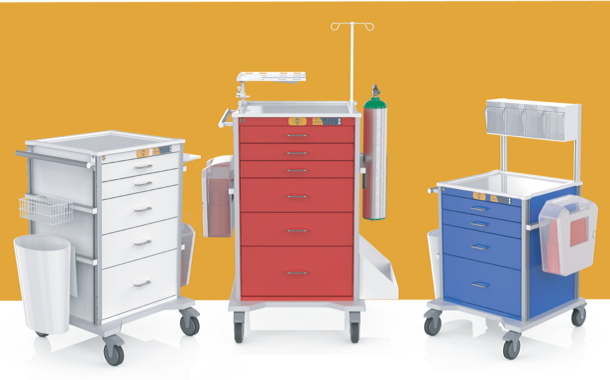9 Key Features to consider when choosing a Medical Cart: An analysis
Medical carts may seem simple pieces of equipment, ubiquitous in many healthcare settings, but there are actually many types of medical carts, each with their own features, specifically designed to suit particular clinical needs. The final product is the result of a great deal of research into how to optimize a range of factors, from durability to maneuverability to good hygiene.
1. Different types of medical carts
One of your first considerations when selecting a medical cart is the particular environment and purpose for which it will be utilized. Some carts will be more general use, and able to adapt to a wide range of situations, others are highly specialized. Most will include basic pieces of equipment such as medication, syringes, and personal protective equipment such as gloves and gowns. A specialized crash cart will have everything needed for when a patient codes, such as defibrillators. A specialized anesthesia cart may prioritize oxygen masks and tracheal tubes. You can tell the difference between different carts by their color. Crash carts are red, anesthesia carts blue, and infection control carts yellow.
2. Available space
Your storage decisions will always need to balance the amount of equipment you need to keep with the space you have available. In line with this, medical carts are designed in different heights and widths. For example, narrower carts may be better when space is limited.
3. Storage capacity
The size and shape of the cart will also affect how much and what type of equipment you can store. This includes on the flat surface, inside any drawers and cupboards, and any additional containers or rails that can be used to store other equipment. Often, these storage options can be reconfigured depending on current needs.
4. Adaptability
Reconfiguring drawers is just one way of adapting a medical cart to a specific situation. For example, you may want a few large drawers, or you may want to insert trays or dividers to allow smaller spaces to be created. A wide range of accessories are available, and you will need to decide which is most compatible with your choice of cart and its intended use.
5. Durability
Hospitals and other healthcare settings can often be fast-paced, particularly during life-threatening emergencies. When carts are being dragged from one place to another, or if they are stationary but regularly bumped by passing people and other equipment, they are at risk of damage. There is also a risk of exposure to chemicals and other toxic substances. You want your cart to stay secure and in one piece to avoid replacing it just months after it is purchased. Durability is particularly impacted by the choice of materials, with a rolled steel body a common and effective choice. It should be welded together to maximize strength and resilience, with powder coating for additional protection.
6. Maneuverability
Part of the point of this kind of medical cart is that it can easily be moved from room to room as required. This means it needs to be maneuverable. Swiveling casters allow the cart to travel down corridors and round corners without difficulty, whilst a lightweight body and accessible handle minimize the strain and risk of injury for healthcare workers.
7. Stability
First, you may need to move the cart into position, but once there, you do not want it rolling away while you are trying to pick up and put down essential and sometimes fragile equipment. Casters should be able to lock in place so when the cart is not in motion, it is stable. This also helps reduce the risk of injury.
8. Good hygiene/infection control
Few things are as important in a healthcare setting as infection control. The materials and design of the cart do not just affect its durability, but also how easy it is to clean. Smooth surfaces are easier to wipe, and seamless joins with minimal corners, nooks, and crannies reduce the build-up of dirt in less accessible areas. Ensure you know which cleaning substances and procedures are recommended for those particular materials.
9. Safety and security
Medications, sharp objects, and expensive equipment are all possible targets for thieves and may be dangerous when accessed by unqualified personnel. Security measures may include manual locks with physical keys, electronic keycards, electronic codes, or even biometrics such as fingerprints. Some carts may combine multiple forms of security, as each has its own advantages and disadvantages. Consider what happens if keys are lost or codes are forgotten.
Conclusion
For a safe and effective healthcare setting, you need safe and effective equipment. This includes the many different types of medical carts. You must consider a wide range of factors to ensure you choose a cart with the right combination of features for your particular environment and needs.

